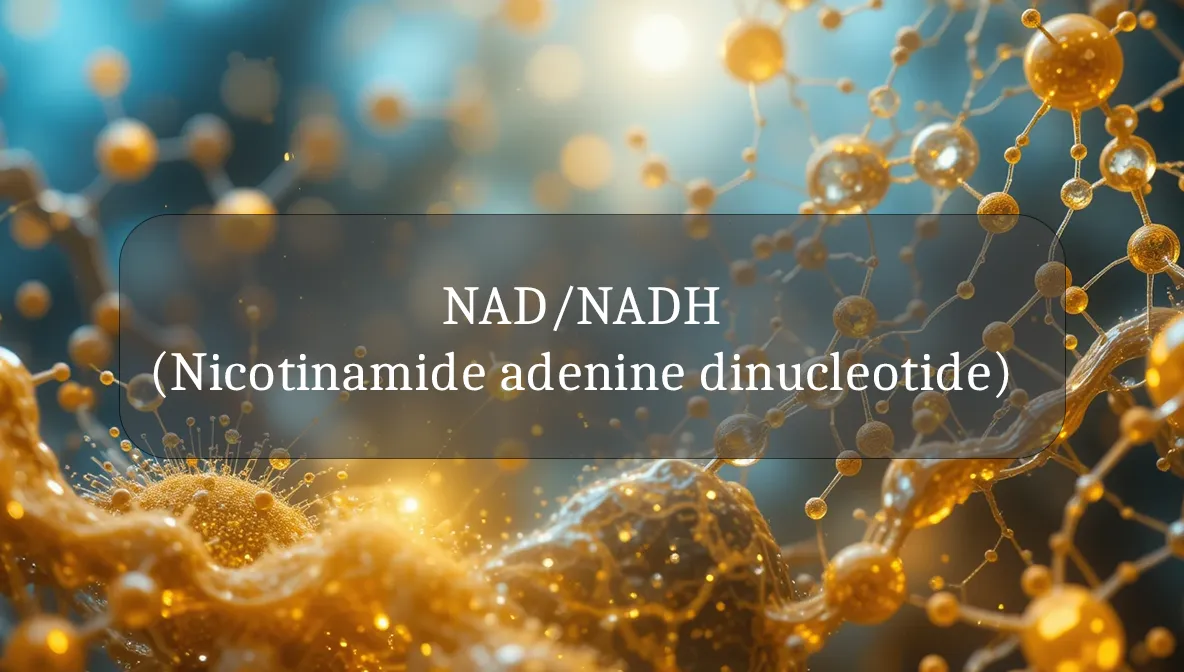Cellular Power Duo for Energy and Longevity
NAD+ (Nicotinamide Adenine Dinucleotide) and its reduced form, NADH, are like the dynamic duo of your cells, driving energy production and supporting processes that keep you youthful and vibrant. These molecules, derived from Vitamin B3 (niacin), are essential for metabolism and cellular health. Let’s explore what NAD+ and NADH are, how they benefit your wellness, and how to support their function for daily vitality.
Chemical Identity and Type
NAD+ is a coenzyme, a molecule that works with enzymes to facilitate chemical reactions in your body. It’s made from niacin (Vitamin B3) combined with adenine (a DNA building block). NADH is the “charged” version of NAD+, carrying extra electrons after picking them up during metabolic processes. Both are found in every cell, shuttling electrons in mitochondria (your cells’ energy factories) and supporting vital functions like DNA repair and gene regulation.
Biological Role and Benefits
NAD+ and NADH are metabolic and longevity powerhouses, delivering benefits that keep you energized and healthy:
- Energy Production: NADH donates electrons to the mitochondrial electron transport chain, producing ATP (your body’s energy currency) to fuel muscles, organs, and brain activity.
- Cellular Repair: NAD+ activates sirtuins and PARPs, proteins that repair DNA and maintain cell health, potentially slowing aging and reducing disease risk.
- Metabolism Support: They help break down carbs, fats, and proteins, ensuring efficient energy use and healthy weight management.
- Antioxidant Defense: NAD+ supports enzymes that neutralize free radicals, protecting cells from damage linked to aging or chronic conditions.
- Brain and Heart Health: NAD+ and NADH support nerve signaling and blood vessel function, promoting cognitive clarity and cardiovascular wellness.
By fueling energy and repair, NAD+/NADH keep you active, sharp, and resilient.
Dietary or Natural Sources
Your body makes NAD+/NADH from niacin (Vitamin B3), so dietary sources focus on B3-rich foods or precursors like tryptophan:
- Meat and Poultry: Chicken, turkey, and beef (3 oz chicken breast: ~7 mg B3).
- Fish: Tuna, salmon, and sardines (3 oz tuna: ~11 mg B3).
- Whole Grains: Brown rice, oats, and fortified cereals (1 cup fortified cereal: ~5–20 mg B3).
- Legumes and Nuts: Peanuts and lentils (1 oz peanuts: ~4 mg B3).
- Vegetables: Mushrooms and avocados (1 cup mushrooms: ~3 mg B3).
- Dairy and Eggs: Milk and eggs provide tryptophan, which converts to niacin (1 cup milk: ~0.2 mg B3 equivalent).
- Supplements: Niacin (nicotinic acid or nicotinamide, 10–50 mg), nicotinamide riboside (NR), or NAD+ boosters (100–300 mg) support NAD+ levels.
A varied diet easily meets B3 needs (14–16 mg daily for adults), ensuring NAD+/NADH production.
Signs of Imbalance or Dysfunction
NAD+/NADH imbalances are tied to low niacin levels or aging, which depletes NAD+:
- Low NAD+/NADH (Niacin Deficiency):
- Fatigue, low energy, or muscle weakness.
- Skin rashes, especially on sun-exposed areas (pellagra).
- Digestive issues like diarrhea or mouth sores.
- Confusion, memory issues, or mood changes.
- Age-Related NAD+ Decline:
- Reduced stamina, slower recovery, or brain fog.
- Increased signs of aging (e.g., wrinkles, joint stiffness).
- Higher risk of metabolic issues (e.g., insulin resistance).
- Excess Niacin:
- High doses (above 50 mg) may cause flushing, itching, or liver strain (nicotinic acid).
- Nicotinamide or NR supplements are safer, with no upper limit set.
If you notice fatigue, skin issues, or cognitive changes, consult a doctor to check for deficiencies or other concerns.
Supporting Optimal Levels or Function
To keep NAD+/NADH thriving:
- Eat B3-Rich Foods: Include 1–2 servings of niacin sources daily (e.g., salmon, peanuts). Adults need 14–16 mg niacin daily (men: 16 mg; women: 14 mg; pregnant: 18 mg).
- Support NAD+ Precursors: Eat tryptophan-rich foods (turkey, eggs) and pair with B6 (bananas, chickpeas) to aid niacin synthesis.
- Try NAD+ Boosters: Nicotinamide riboside (NR, 100–300 mg daily) or nicotinamide mononucleotide (NMN) supplements may raise NAD+ levels, especially for aging or high-energy needs.
- Exercise Regularly: Moderate exercise (e.g., walking, strength training) boosts NAD+ production and mitochondrial health.
- Limit Alcohol and Stress: Excessive alcohol or chronic stress depletes NAD+. Practice moderation and relaxation techniques like meditation.
Consult a doctor before starting NAD+ boosters, especially with health conditions.
Safety, Interactions, and Precautions
NAD+/NADH and niacin are safe when balanced, but caution is needed:
- Niacin Side Effects: High-dose nicotinic acid (above 50 mg) causes flushing or, rarely, liver damage. Nicotinamide or NR avoids flushing and is safer.
- Medication Interactions: Niacin may interact with statins (cholesterol meds) or diabetes drugs, affecting blood sugar or liver function. Discuss with your doctor.
- Medical Conditions: If you have liver disease, gout, or diabetes, use niacin supplements cautiously under medical supervision.
- Allergies: Rare reactions (rash, nausea) can occur with supplements. Choose high-quality, tested products.
Fun Fact
Did you know NAD+ is a key player in the “longevity” puzzle? Scientists study it for its role in activating sirtuins, proteins linked to longer, healthier lifespans in animals—making NAD+ a hot topic in anti-aging research!
Citations
- National Institutes of Health (NIH): Niacin Fact Sheet for Health Professionals.
- Mayo Clinic: Vitamin B3 and Metabolism.
- Cleveland Clinic: Mitochondrial Health and Coenzymes.
- Journal of Cell Metabolism: NAD+ and Aging (2021).
- Harvard T.H. Chan School of Public Health: The Nutrition Source – Niacin.

